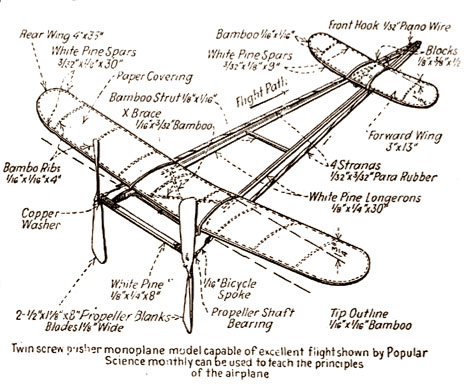
by Martin Gregorie
A-frames were the first successful type of flying model. The name comes from the shape of the structure supporting the propellers and wings. They were canards with the stabiliser set in front of the main wing and had no rudders or vertical fins. For years, twin pushers were the dominant form of competition model. The lay-out was discovered well before the first world war and remained common until the mid thirties.
The basic formula is a main wing and stabiliser arranged in the Canard format and mounted on an A-frame. The legs of the A-frame each hold a long rubber motor and a pusher propeller which rotate in opposite directions. The A-frame forms a strong cross-braced support for the rubber. The counter rotating props eliminate the torque problems. This was a huge benefit in a time when thrust line adjustments were not well understood. The pusher props supply stability by acting as rudders while the A-frame forms an excellent mountin for canard flying surfaces. They require very long, thin rubber motors which give a long, slow climb. Despite this, A-frames regularly get high enough for HUNG, the thermal god, to accept them as offerings. They must be built very light to fly well.
The A-frame lay-out was a good solution to the problem of how to make a rubber powered free flight model. The models have a "rightness" about them, like a good tool. They are as highly developed as a broom or a triple expansion marine steam engine.

I've never flown an A-frame or seen one fly but I know model fliers who still build and enjoy them.